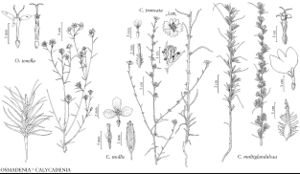Calycadenia mollis
Proc. Amer. Acad. Arts 7: 360. 1868.
Plants 30–90 cm; self-incompatible. Stems usually simple, often zigzag-curved, ± hirsute, long-soft-hairy, ± glandular. Leaves mostly alternate, 2–8 cm (often longest at midstems), hirsute, ± long-hairy, ± glandular. Heads usually (3–10+) in dense, cymiform arrays. Peduncular bracts oblanceolate, 3–9 mm (flat, flexible, margins thickened or rolled, hirsute to hispid, usually bristly, especially margins, ± glandular), apices rounded, tack-glands usually 3–6+, confined to margins. Phyllaries 4–6 mm, abaxial faces spreading-hairy (hairs mixed, short, slender hairs and longer bristles), densely glandular, tack-glands usually 0. Paleae 4–6 mm (tack-glands usually 0). Ray-florets 1–4; corollas yellow, white, or rose, tubes ca. 2 mm (papillate, throats often with red “eyes”), laminae 5–6 mm (central lobes slightly narrower than laterals, nearly symmetric, widest beyond middles, sinuses usually 3/4+ laminae). Disc-florets 2–10; corollas yellow to white or rose, ca. 5 mm. Ray cypselae ca. 2.5 mm, usually rough-wrinkled, glabrous or glabrate. Disc cypselae ca. 2.5 mm, ± appressed-hairy; pappi 6–8 usually lanceolate-aristate (often 1–3 shorter, blunt) scales 2–5 mm. 2n = 14.
Phenology: Flowering spring–summer.
Habitat: Open, dry meadows, fields
Elevation: 100–1500 m
Discussion
Calycadenia mollis grows in the Sierra Nevada foothills from Tuolumne County to Tulare County.
Selected References
None.

